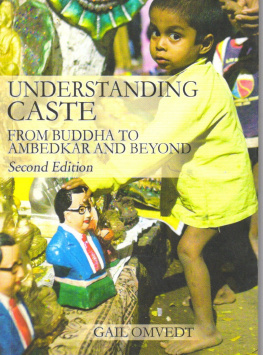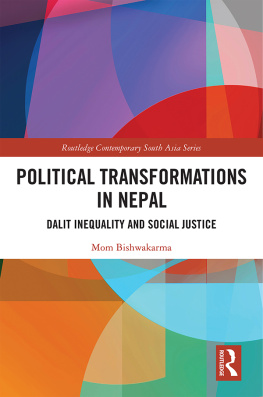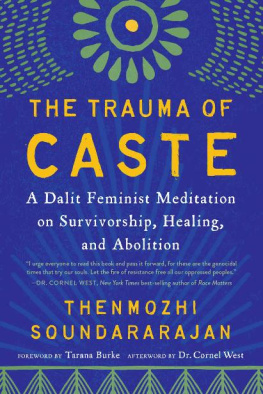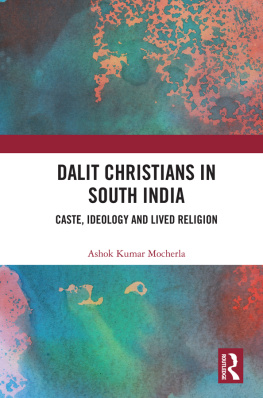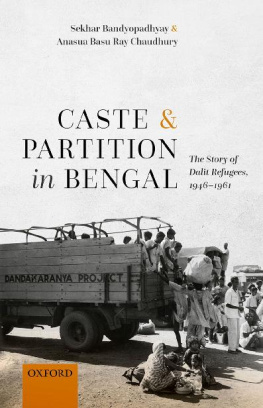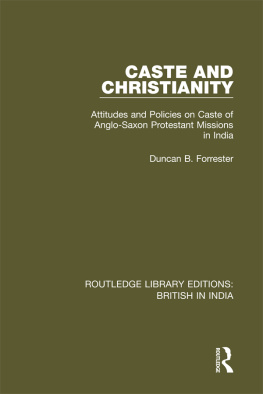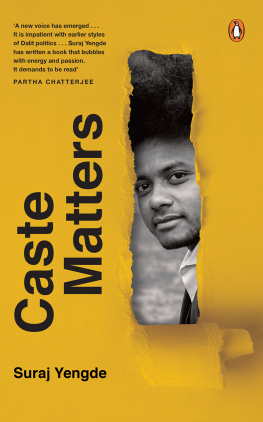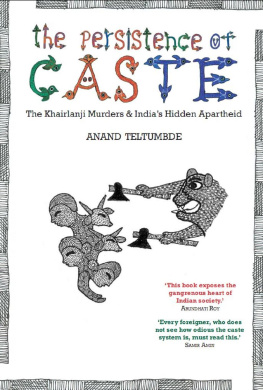CONTENTS
UNDERSTANDING CASTE
FROM BUDDHA TO AMBEDKAR AND BEYOND
GAIL OMVEDT
This book was produced in EPUB format by the Internet Archive.
The book pages were scanned and converted to EPUB format automatically. This process relies on optical character recognition, and is somewhat susceptible to errors. The book may not offer the correct reading sequence, and there may be weird characters, non-words, and incorrect guesses at structure. Some page numbers and headers or footers may remain from the scanned page. The process which identifies images might have found stray marks on the page which are not actually images from the book. The hidden page numbering which may be available to your ereader corresponds to the numbered pages in the print edition, but is not an exact match; page numbers will increment at the same rate as the corresponding print edition, but we may have started numbering before the print books visible page numbers. The Internet Archive is working to improve the scanning process and resulting books, but in the meantime, we hope that this book will be useful to you.
The Internet Archive was founded in 1996 to build an Internet library and to promote universal access to all knowledge. The Archives purposes include offering permanent access for researchers, historians, scholars, people with disabilities, and the general public to historical collections that exist in digital format. The Internet Archive includes texts, audio, moving images, and software as well as archived web pages, and provides specialized services for information access for the blind and other persons with disabilities.
Created with abbyy2epub (v.1.7.2)
ORIENT BLACKSWAN PRIVATE LIMITED
Registered Office
3-6-752 Himayatnagar, Hyderabad 500 029 (A.P), India
e-mail: centraloffice@orientblackswan.com
Other Offices
Bangalore, Bhopal, Bhubaneshwar, Chandigarh, Chennai, Ernakulam, Guwahati, Hyderabad, Jaipur, Kolkata, Lucknow, Mumbai, New Delhi, Noida, Patna
Orient Blackswan Private Limited 2011 First Published 2011
ISBN 978 81 250 4175 7
Typeset by
Le Studio Graphique, Gurgaon 122 001 in Bembo 11/13
Printed at
Glorious Printers Delhi
Published by
Orient Blackswan Private Limited 1/24 Asaf Ali Road New Delhi 110 002 e-mail: delhi@orientblackswan.com
Introduction
For most people, even scholars, Hinduism has been a taken-for-granted concept. Hindus are the people of India. Hinduism is their religion. Beginning with the Rg Veda to the philosophers and even contemporary political leaders, it has been seen as a unique phenomenon of spirituality linked to a practical life; and with a solid geographical base in a diversified subcontinent. Although its stability has been broken from time to time by invasions, conquests and disturbances, it has nevertheless maintained a fair continuity. It has given birth to rampant and unjustifiable social inequalities but has also spawned the protests against these. Its greatest virtue has been its elasticity, its pluralism, its lack of dogma. Hinduism, it is said, has no orthodoxy (though it may have an orthopraxy). With a core in the religious tradition going back to the Vedas and Upanishads, it has brought forth other sister/child religions Jainism, Buddhism, Sikhism all born out of the same fertile continuate of tradition, all part of India and Hinduisms contributions to the world.
This image, encompassing the cultural diversities of the subcontinent and subordinating them to a Vedantic core, has pervaded both popular and scholarly writings on India. To take but one example, two scholars of religion in Maharashtra draw together dalit, Marxist and bhakti traditions in a book entitled The Experience of Hinduism, only to give Vedantam the last word:
Buddhists Jains, Muslims, Christians, nay even the Marxists, of todays India cannot help partaking of itthey are all Hindu-Bharatiya at heart.,..What is it to be a Hindu-Bharatiya? What does it involve? Chiefly, the accepting of the other world as well as this world, the attempt to reconcile the two. But between the two the other world comes first. Brahman and mava are both real, but brahman is the ultimate reality..-. This ultimate/provisional duality has been resolved into a unity in the Vedanta of nonduality. (Bhave 1988, 318-19)
There are many who would contest this violently, and as we shall see the Indian tradition is much more than Hinduism so defined. What is more striking, though, is that behind the image of flexibility and diversity is a hard core of an assertion of dominance. Between the two the other world comes firstthis assertion leads to the political line of the Vishwa Hindu Parishad (VHP) that there may be various versions of what is defined as the Hindu tradition (Sikhism, Buddhism. Jainism, Arya Samaj and Sanatan dharma are the ones usually mentioned), but there is no question that the core is traditional Hinduismwhat is known, somewhat fallaciously, as sanatan dharma.
Out of the pleasantries of the official ideology of Hindu pluralism and tolerance and under the pressures of contemporary material deprivation and economic turbulence, has grown the modern politics of Hindutva militant Hinduism, Hinduism as nationalism. It makes a simple addition to the claim that Hinduism is the main religion of the people of India: Hinduism is the national religion, the peoples tradition in the subcontinent, but it has been attacked, smothered, insulted, dishonoured, first by Muslim aggressors, then by British colonialism, and now by the contemporary State which in its self-definition as secular is dishonouring it in its own land and pampering Muslim and Christian minorities. Hinduisms great virtue was its generous tolerance of other faiths, but its enemies have taken advantage of this; Hindus must now be strong, fierce and proud, and not hesitate to assert themselves.
Today, large sections of left and democratic forces and all new social movements are trying to argue and organise against the growing influence of Hindutva or Hindu-nationalism.The majority of these have taken a position against communalism but not against Hinduism as such. The secular version of this opposition argues that Indians must come together beyond their religious identities, as citizens of a nation and as human beings. It is exemplified in the popular anti-communal song Mandir-Masjid:
In temples, mosques, gurudwaras
God is divided.
Divide the earth, divide the sea,
But dont divide humanity.
The Hindu says, The temple is mine,
The temple is my home.
The Muslim says, Mecca is mine,
Mecca is my loyalty.
The two fight, fight and die,
Get finished off in fightingThe song goes on to describe the machinations of political leaders and the perpetuation of exploitation through communalism, but interestingly enough, even its appeal to a common identity draws on (and reproduces?) the notion that India is the home of the Hindus, while the Muslims find their loyalties elsewhere.
An even more eloquent version can be found in Kabir,
The Hindu says Ram is dear,
The Muslim says Rahiman
They quarrel, fight and kill each other
Never knowing the essence.Another mode of opposing communalism is to re-appeal to Hindu traditions themselves, a position that has been developing among several anti-communal Delhi intellectuals over the last few years. This has been eloquently voiced by Madhu Kishwar in a number of Manushi articles which argue in defence of our dharma. Agreeing with the condemnation that Nehruvian and modern left secularism are insufficient to deal with the need for identity, she appeals to bhakti traditions as the true Hinduism, and argues that the militaristic image of Rama is a distortion, and that much of casteism is in fact a colonial heritage. This position has antagonised many secular feminists, but there is no denying that it is persuasive to many, particularly to middle-class, upper-caste Indians. Even the upper-caste left is being increasingly drawn to it. This is illustrated by the poster of the Sampradayikta Virodhi Abhyan (SVM): the mask of Rama, the form of Ravana.The SVM thus appeals to the gentle image of Rama and takes for granted the demonical quality of Ravana.

